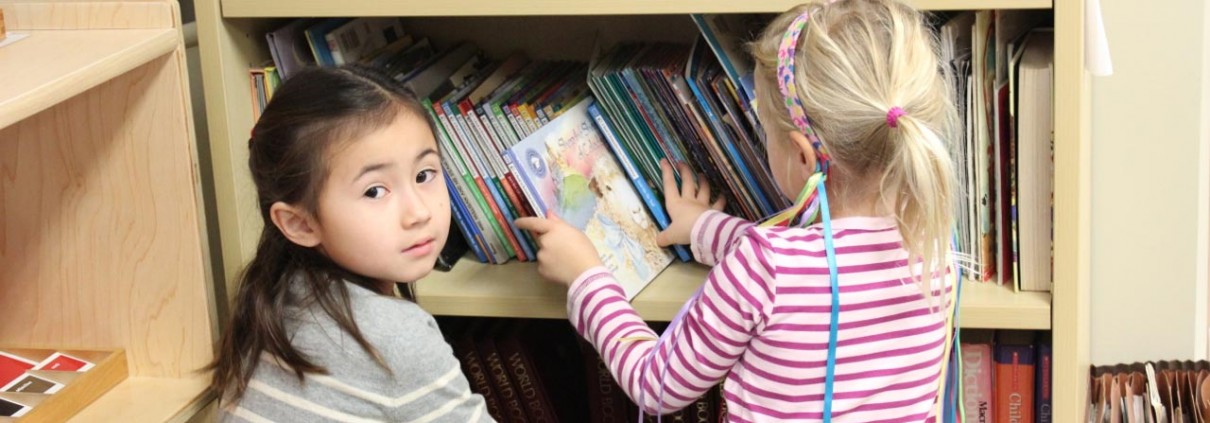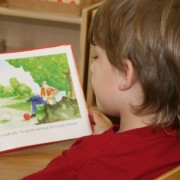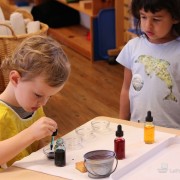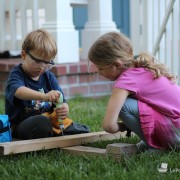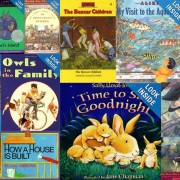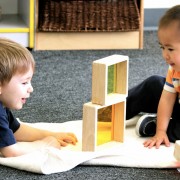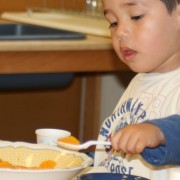Applying Montessori Ideas When Reading With Your Child
Part four of four of our reading aloud blog post series
While the "why" of reading aloud to children is discussed everywhere, the equally important "how"often receives short shrift. That’s unfortunate, because as valuable as it is to know why reading together is important, it is getting better at reading with your child that will actually ensure that the experience is mutually joyous, and help you build it into your routine.
Here are some Montessori-inspired ideas to implement as you read with your child:
- Embrace and celebrate repetitive reading. Most preschoolers love to read the same books, over and over again, just like they go back to favorite activities in their Montessori classrooms. This need for repetition is a wonderful opportunity for learning during read-alouds: it is often when we read a story the 5th or 10th time that children begin to use its words, or remember its moral lessons. And it’s only during the preschool, picture book years that we have this audience eager to read the same book over and over again! Make the most of these few years by reading books at different levels:
- Read for the story during the first take. Get caught up in it, and read through with limited stops, maybe just to explain a key term here and there, and to answer a brief comprehension question. Talk about the story afterwards.
- Become progressively more interactive on subsequent reads. Stop to give short definitions of vocabulary terms ("An dwelling is a house, a place someone lives. Our dwelling has green walls, and a big garden around it.") Point out interesting things in the illustrations. Talk about why the events happen, how the people in the story feel, how the setting compares to the world your children live in. There are some good articles out there detailing how to implement interactive reading, but the general principle is to guide your children to be interactive explorers of the books they read!
- Integrate ideas across books and into your child’s real-world experience. When we study literature in the upper grades at LePort, we explicitly highlight the ways in which books are guides for better living: we discuss the moral lessons books offer, and help children draw on literary experiences to illuminate the choices they make in their own lives. While we’d not suggest quite such an abstract approach for preschoolers, there are many ways you can connect the reading you do to your children lives, even at age 3 or 5:
- Consciously use a book’s vocabulary in your daily conversations. ("I’m exasperated right now, Max, because your crayons are all over the floor!") Repeating and using the vocabulary from books will reinforce the learning, and help your child comprehend the new words and use them actively in speaking and writing. It also develops an implicit awareness in your child that the language in a book can be extended to life as such.
- Highlight how your child’s experiences relate to those of characters and settings in books. ("You found a creative solution here, instead of giving up, just like Sadie did in Sadie and the Snowman!" "I know this flu shot hurts, but it’s better than the prospect of sending you away for months, like Marvin’s parents had to do in the book we read.") Engage in real-world activities that relate to the books you read: go to a park to look for butterflies after reading Where Butterflies Grow; bake bread after reading Sunbread; re-read Hello Oceanbefore a trip to the beach.
- Make connections for your child between different books. Highlight similarities and differences, and tie them to your child’s experience. ("See, the family in When I Was Young in the Mountains has to heat their house with a wooden stove, just like Laura’s family did in The Little House on the Prairie! We don’t need to cut wood today, or light a fire, or clean a messy stove; we have gas furnaces that work at the flick of a switch.")
- Let your child choose books. While you need to do the initial selection, especially for those books you buy and expect to read over and over again, let your child choose from the books you selected. It’s fun to discover which books your child likes—and a great starting point for conversation about values and choices we make: why is this book a favorite? Why doesn’t he like that one? Once they are older, let children pick library books, even those you may not love: it helps to have an occasional not-so-exciting book to highlight the special joy we get from better ones!
- Provide firm guidance around reading behavior. In our house, my son loves books, and he’s a born story-teller. Often, he’ll take the first opportunity during reading time to launch off into a story of his own. Sometimes, when it’s just the two of us, I’ll follow his lead, and reading morphs into 20 minutes of my 4-year-old spinning his own yarns. At other times, when we read with his sister or visiting friends, he has learned that he needs to raise his hand or put it on my arm to let me know he has something to say when we get to a stopping point in the book. Making reading interactive does not mean anything goes: interrupting constantly, talking with dolls, or running around usually means the reading stops, until the children choose to pay attention again. It’s the same "freedom within limits" approach your child experiences in our Montessori classrooms, and it can work just as well at home!
- Never tie rewards or punishments to reading. While there are many programs that offer incentives for children to read (free Pizza, anyone?), we recommend never tying reading to any rewards or punishments. Don’t reward reading; don’t offer reading as a reward; don’t withhold reading as a punishment. Extrinsic rewards or punishments debase the activity they are tied to, and reading is just too important an experience to risk!
If you can make reading something you and your children treasure, infuse it with meaning by selecting great books, and make it a pleasant, interactive experience, you’ll do something amazing: you’ll lay the foundation for a love of reading in your child—and create a storehouse of wonderful, shared memories.

